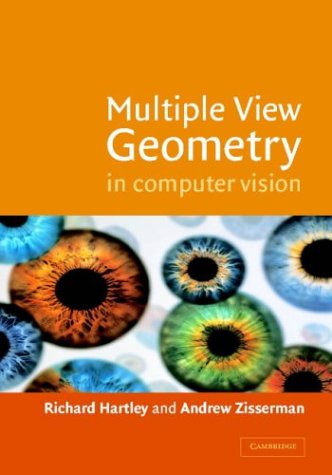
Synopsis
How to reconstruct scenes from images using geometry and algebra, with applications to computer vision.
Les informations fournies dans la section « Synopsis » peuvent faire référence à une autre édition de ce titre.
Revue de presse
'I am very positive about this book. The authors have succeeded very well in describing the main techniques in mainstream multiple view geometry, both classical and modern, in a clear and consistent way.' Computing Reviews
'... a book which is timely, extremely thorough and commendably clear ... Overall, the approach is masterly ... The authors have managed to present the very essence of the subject in a way which the most subtle ideas seem natural and straightforward. I have never seen such a clear exploration of the geometry of vision. I would wholeheartedly recommend this book. It deserves to be in the library of every serious researcher in the field of computer vision.' Journal of Robotica
'The new edition features an extended introduction covering the key ideas in the book (which itself have been updated with additional examples and appendices) and significant new results which have appeared since the first edition. Comprehensive background material is provided, so readers familiar with linear algebra and basic numerical methods can understand the projective geometry and estimation algorithms presented, and implement the algorithms directly from the book.' Zentralblatt MATH
Présentation de l'éditeur
A basic problem in computer vision is to understand the structure of a real world scene given several images of it. Techniques used in the book for solving this are taken from projective geometry and photogrammetry. The authors cover the geometric principles and their algebraic representation in terms of camera projection matrices, the fundamental matrix and the trifocal tensor. The theory and methods of computation of these entities are discussed with real examples, as is their use in the reconstruction of scenes from multiple images. Recent major developments in the theory and practice of scene reconstruction are described in detail in a unified framework. The authors provide comprehensive background material, so a reader familiar with linear algebra and basic numerical methods will be able to understand the projective geometry and estimation algorithms presented, and implement the algorithms directly from the book.
Les informations fournies dans la section « A propos du livre » peuvent faire référence à une autre édition de ce titre.
Autres éditions populaires du même titre
Résultats de recherche pour Multiple View Geometry in Computer Vision
Multiple View Geometry in Computer Vision
Vendeur : Mispah books, Redhill, SURRE, Royaume-Uni
hardcover. Etat : Good. Good. Dust Jacket NOT present. CD WILL BE MISSING. . SHIPS FROM MULTIPLE LOCATIONS. book. N° de réf. du vendeur ERICA82905216230494
Acheter D'occasion
Expédition depuis Royaume-Uni vers Etats-Unis
Quantité disponible : 1 disponible(s)

